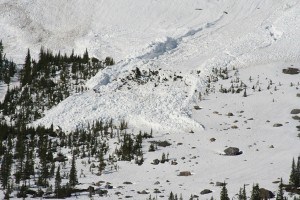
As the world said goodbye to 2016, backcountry enthusiasts got a sober reminder about the dangers of playing in the mountains.
On Dec. 30 a snowmobiler got caught in an avalanche in the Clemina Creek recreational area about 20 kilometres southeast of Valemount.
According to media reports, Robson Valley search and rescue were notified of the accident after someone on scene activated a SPOT beacon, which sends a signal notifying authorities of an emergency. The other two people he was with were partially buried in the avalanche but were able to ride out of the area uninjured.
Due to avalanche conditions, officials had to wait until the following day to get a helicopter crew from Jasper National Park into the area to recover the body.
On Dec. 31 a deceased male was recovered. The identity of the victim hasn’t been released.
The tragic circumstances of this event are a wake up call for anyone thinking about heading into the backcountry this winter and a reminder that one wrong decision can have fatal consequences.
Following the event, Avalanche Canada published a blog post reminding skiiers and snowmobilers that good intentions to help those in trouble may have tragic consequences.
“Minimizing the number of people exposed to a hazard is a basic tenet of good risk management, but it’s often easier said than done,” wrote Ilya Storm, a forecast coordinator for Avalanche Canada.
“A skier falls, loses their ski, and three people spend 10 minutes looking for it in the deep powder. Or a sledder gets stuck on a slope and two people come in to help, resulting in three people on the slope at once. People trigger avalanches, and are injured or killed by the avalanches they start.”
According to him, 90 to 95 per cent of avalanches that kill people are triggered by the victim, or someone in their group, which is likely what happened in Clemina Creek.
“Our preliminary analysis is that one person was dealing with their stuck sled, two people were riding above, quite possibly coming to assist their buddy, and one of those three people triggered the fatal avalanche. All three were caught, one was on the surface, one partially buried, and the person who lost their life was fully buried,” wrote Storm.
Rather than pointing blame, he took the time to remind backcountry enthusiasts some basic rules to avoid getting caught in an avalanche.
Riders/Skiers
* If you’re in avalanche terrain and stuck, expect to dig and get yourself out by yourself.
* Recognize there are better or worse times, and places, to get stuck.
Group Members
* Watch from a safe spot off to the side and well back, out of harm’s way.
* Give the rider time to sort it out by themselves.
* Plan how to help the rider if required: send in only one person and keep spotters watching – they’re the potential rescuers; consider how to approach (from below or the side, not from above, avoid steepest terrain, avoid trigger points, manage terrain traps, etc).
Hopefully these reminders and visiting avalanche Canada’s website for up to date information about avalanche conditions will help us avoid another tragic avalanche in the weeks and months ahead. Stay safe!
